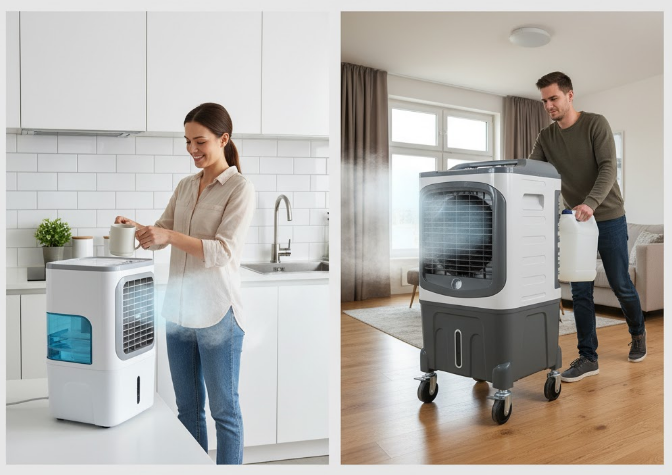
Here’s the part most people miss: the size of the water tank isn’t just some spec on a box – it affects how often you have to deal with it. And unless you’re one of those rare folks who enjoys checking water levels like it’s a ritual, the tank size matters more than you’d think, especially when it comes to managing kitchen equipment that’s supposed to make life easier, not more complicated.
Smaller tanks run out fast. It’s not the end of the world, but when the heat’s rolling in and the air stops being cool because you forgot to refill it – yeah, you’ll feel it. That’s when the frustration creeps in, and suddenly your kitchen feels less like a work zone and more like a burden.
Larger tanks? Less drama. Fill it once, walk away, and you’re not babysitting it all day. But they take up more room, and when they’re full, they don’t exactly glide across the floor like a feather.
Why Small Tanks Make Sense… Until They Don’t
They’re kind of like a moped – easy to use, great for short rides, but not built for cross-country trips. Perfect for someone who needs quick, occasional relief without taking up half the room.
Here’s what works:
- Easy to move around – No hernia risk, no wheezing just from lifting it.
- Minimal space needed – Good for tight setups where every inch counts.
- Quick to refill – If the sink’s nearby, topping it off isn’t a huge deal.
But if you’ve got it running all day, you’re going to get tired of hearing the low water alert – or worse, noticing the air’s warm again because you missed it.
These coolers are a fit for short, targeted use. Anything beyond that, and they start to feel a little needy.
The Bigger Tanks: Practical, If You’ve Got the Room
These coolers mean business. You’re not refilling them every couple of hours, and the airflow tends to be stronger, too. They’re built for bigger rooms or longer use periods – living rooms, studios, garages, that kind of thing.
Here’s where they shine:
- Long runtime – Fill it once and relax; it’s not clock-watching.
- More power – Most large tanks come with fans that actually push some serious air.
- Better for shared or larger spaces – Great when more than one person needs the cool air.
But let’s be honest: they’re heavy when full, a pain to move, and unless you’ve got space to spare, they’re going to be a bit of an eyesore. You can’t tuck these things away like a lamp.
If you plan on using the cooler all day or in a space that gets seriously warm, though, this size is just more practical – even with the extra bulk.
Which One’s Actually Better? Depends on You
This isn’t one of those one-size-fits-all situations. What’s ideal for someone in a small apartment might drive someone else nuts in a bigger house.
Ask yourself a few things:
- How often will it be on?
- Will you move it between rooms?
- Is the water source close, or do you need to lug a jug across the house?
- Do you hate interruptions, or don’t mind checking in every few hours?
If you’re cooling a personal space for a couple of hours a day and you’re okay topping it off more often, the small tank does the job. But if you’re using it for longer hours or a wider area and you don’t want to mess with it all the time, go for the big one.
There’s no gold medal here – just common sense and how you live.
Here’s the Straight Truth
You’ll hear a lot of fancy talk from people trying to sell you features. “Smart sensors,” “cooling zones,” “ultra-quiet tech” – all that jazz. But none of that helps if the tank’s empty when you need it or the cooler’s too bulky to even use comfortably.
Pick what fits your life, your space, and your patience level. The rest? Just noise.